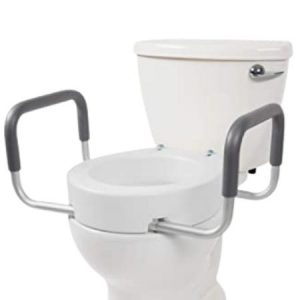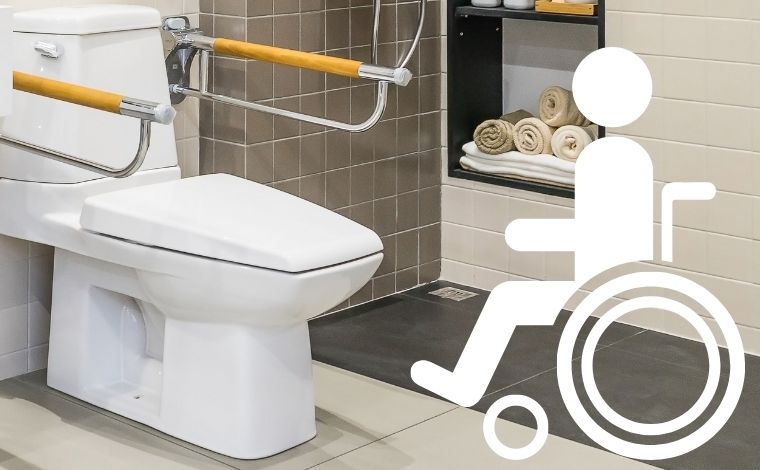Modern bathrooms are no longer just about looks — they’re about accessibility, comfort, and safety. In the past, most toilets were built in a one-size-fits-all style. But for many people with disabilities, injuries, or age-related mobility issues, a standard toilet can be extremely hard to use. That’s why handicap toilets, also known as ADA-compliant or accessible toilets, were designed.
These toilets follow specific standards set by the Americans with Disabilities Act (ADA). They ensure that individuals who use wheelchairs or have mobility limitations can use the restroom independently and comfortably.
A key part of this design is the height. It determines how easy or difficult it is for a person to sit down and stand up. Knowing the correct handicap toilet height helps you build a truly inclusive bathroom — whether it’s at home, in an office, or in a public space.
What Is a Handicap Toilet and Why Is It Important?
A handicap toilet is more than just a taller version of a normal toilet. It is specially designed with space, height, and support to make it easy for everyone — especially those who face physical challenges — to use safely and comfortably.
These toilets have several key features that make them different from standard models:
-
Higher Seat Height: Reduces strain while sitting or standing.
-
Grab Bars Nearby: Provides extra support and balance.
-
Wider Space Around the Toilet: Allows wheelchair access.
-
Easy-to-Use Flush Controls: Requires minimal effort to operate.
In essence, the goal is to create a bathroom where everyone — disabled, elderly, or otherwise — can maintain independence. ADA-compliant designs don’t just benefit people with disabilities; they make life easier for the elderly, pregnant women, and even children learning to use the toilet safely.
ADA-Recommended Handicap Toilet Heights for Adults and Children
The height of the toilet seat is the most important factor that makes a toilet “handicap-friendly.”
Here’s a breakdown of the standard measurements that ADA recommends for different users:
1. Standard ADA Toilet Height (for Adults)
-
Recommended Height: 17–19 inches from floor to seat top.
-
Purpose: Easier for adults with disabilities or limited mobility.
-
ADA Compliance: Fully compliant with accessibility standards.
Even a difference of 2–3 inches from a regular toilet can make sitting and standing significantly easier. It allows for a more natural transition, especially for wheelchair users or those with knee pain.
✅ Best Model Example: TOTO Drake Eco Gravity Flush Toilet — a strong, comfortable ADA-approved toilet with a smooth design.
2. Regular Standard Toilet Height (Non-ADA)
-
Height: 14–16 inches.
-
Purpose: Common in regular households and compact bathrooms.
While this is comfortable for many users, it’s not ideal for those who struggle to bend their knees or lower themselves too far.
Recommendation: Install TOTO Vespin II 14″ rough-in toilet
✅ Alternative Choice: TOTO Vespin II 14″ Rough-In Toilet — standard height, modern design.
3. Handicap Toilet Height for Children
Children need toilets that are shorter, safer, and easy to reach. ADA also provides measurements for them:
-
Toddlers (3–5 years): Around 12 inches tall.
-
School-Age Children (5–12 years): About 15 inches tall.
-
Teens (12+): Can use standard ADA height (17–19 inches).
✅ Popular Option: American Standard Cadet Pro Toilet — perfect for schools and family homes.
4. Rough-In Dimensions
-
Standard Rough-In: 12 inches from wall to drain center.
This size is common in both standard and accessible toilets, making installation simple.
Adjustable and Multifunctional Handicap Toilets
Thanks to modern innovation, we now have adjustable-height toilets that can be customized according to user needs. These are perfect for mixed-use homes where both disabled and non-disabled people share the same bathroom.
Recommendation: Toto Drake Eco Gravity Flush Toilet
Why they’re popular:
-
Can be adjusted for both adults and children.
-
Suitable for elderly parents or guests with mobility issues.
-
Saves space and money — one toilet fits all users.
-
Blends easily into any modern bathroom design.
Some models feature removable seat risers or electric height controls, making them extremely flexible. You can even buy comfort-height seats separately if you already have a regular toilet and want to upgrade it for accessibility.
✅ Pro Tip: Choose a toilet with a slow-close lid and side flush lever for added comfort and safety.
Recommendation: Toto Drake Eco Gravity Flush Toilet
Essential Features That Make Handicap Toilets Truly Accessible
While height is crucial, real accessibility comes from a combination of design elements. If you’re setting up an ADA-compliant bathroom, pay attention to these extra features that make all the difference:
-
Grab Bars: Should be placed 33–36 inches above the floor for safe balance and transfer.
-
Raised Toilet Seat: A contoured or padded seat improves comfort.
-
Flush Handle Position: Should be easy to reach without twisting or stretching.
-
Adequate Space: Leave at least 60 inches of turning radius for wheelchair movement.
-
Door and Entry Design: The door should be at least 32 inches wide and open outward.
-
Lighting and Safety: Use bright lights, anti-slip flooring, and motion sensors for added convenience.
-
Emergency Support: In public restrooms, consider including a pull cord or alert button for emergencies.

These features together ensure that the bathroom is safe, practical, and comfortable for all users. An accessible toilet shouldn’t feel clinical or out of place — with the right design choices, it can look stylish while being fully functional.
Best Suit: American Standard Cadet Pro Toilet
Final Thoughts — Choosing the Right Handicap Toilet
Building an inclusive home or facility starts with small but meaningful decisions, and choosing the right toilet is one of them. A standard handicap toilet height of 17 to 19 inches may not seem like much, but it makes a huge difference for users who value safety and independence.
Here’s a quick summary of what to remember:
- Adult ADA Toilet Height: 17–19 inches.
- Children’s Handicap Toilet Height: 12–15 inches.
- Regular Toilet Height: 14–16 inches.
- Rough-In Distance: 12 inches (standard).
If you’re remodeling or building a new bathroom, consider going for a comfort-height or ADA-compliant model. It ensures comfort for the elderly, disabled guests, and even for future use if your own mobility changes with age.
Trusted brands like TOTO, Kohler, and American Standard offer elegant ADA-approved models that blend well with any decor. Many include dual-flush systems for water saving and sleek designs that don’t compromise aesthetics.
A truly accessible bathroom is one that everyone can use without stress or help. Whether you’re creating a home for aging parents or just planning ahead, investing in an ADA-compliant toilet ensures safety, dignity, and independence for years to come.
Even a few extra inches in toilet height can transform everyday life — turning an ordinary bathroom into a space of comfort, convenience, and care.
Hi, this is Robert Crossan, the owner of this website, has 17 years of experience in the installation, maintenance, and repair of toilets and plumbing systems. After completing the Level 2 Basic Plumbing course in 2005, I started working in both domestic and commercial buildings as a professional plumber. So I can figure out the core difference between different toilet models and brands. It also helped me monitor their work performance and setbacks.
